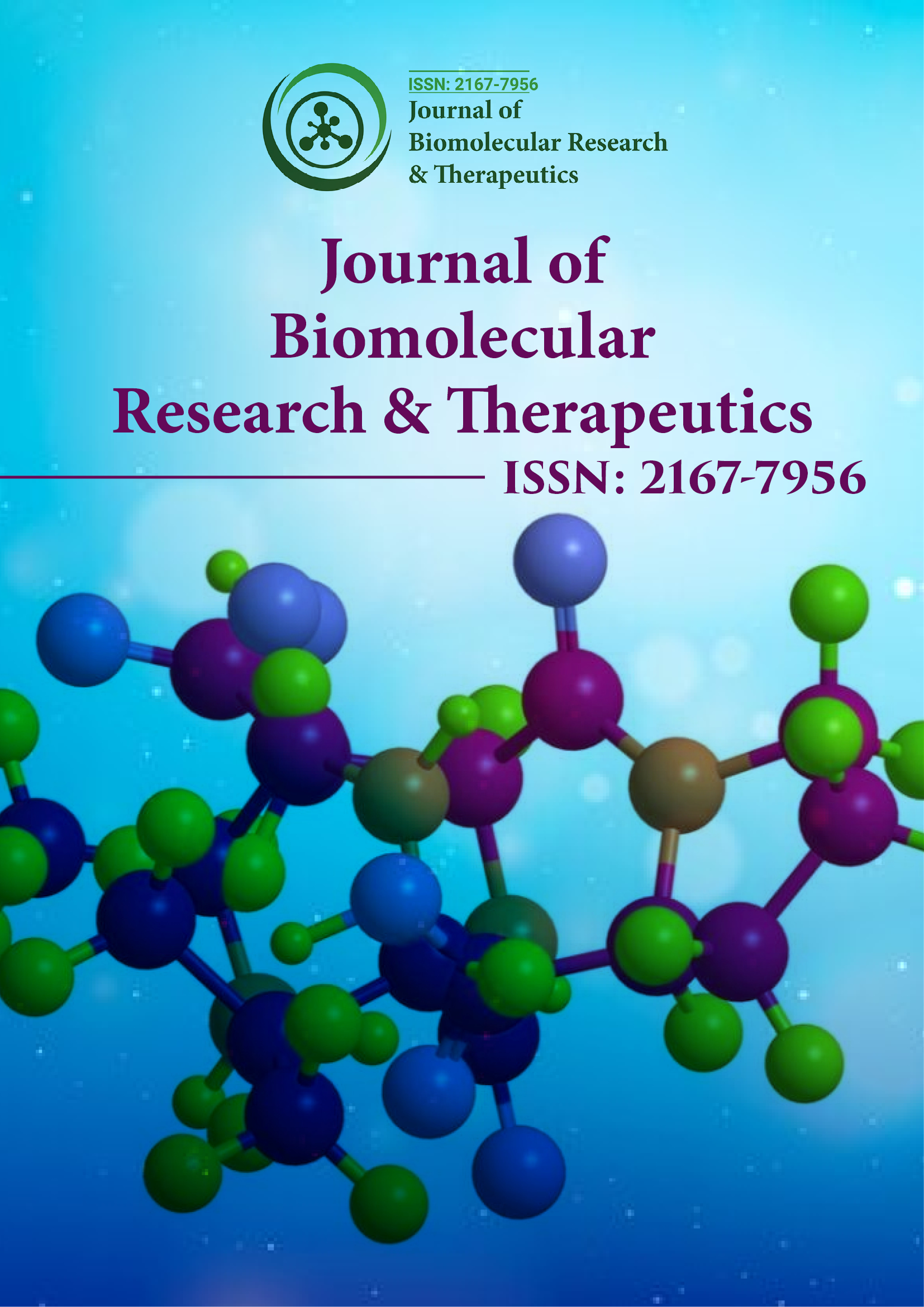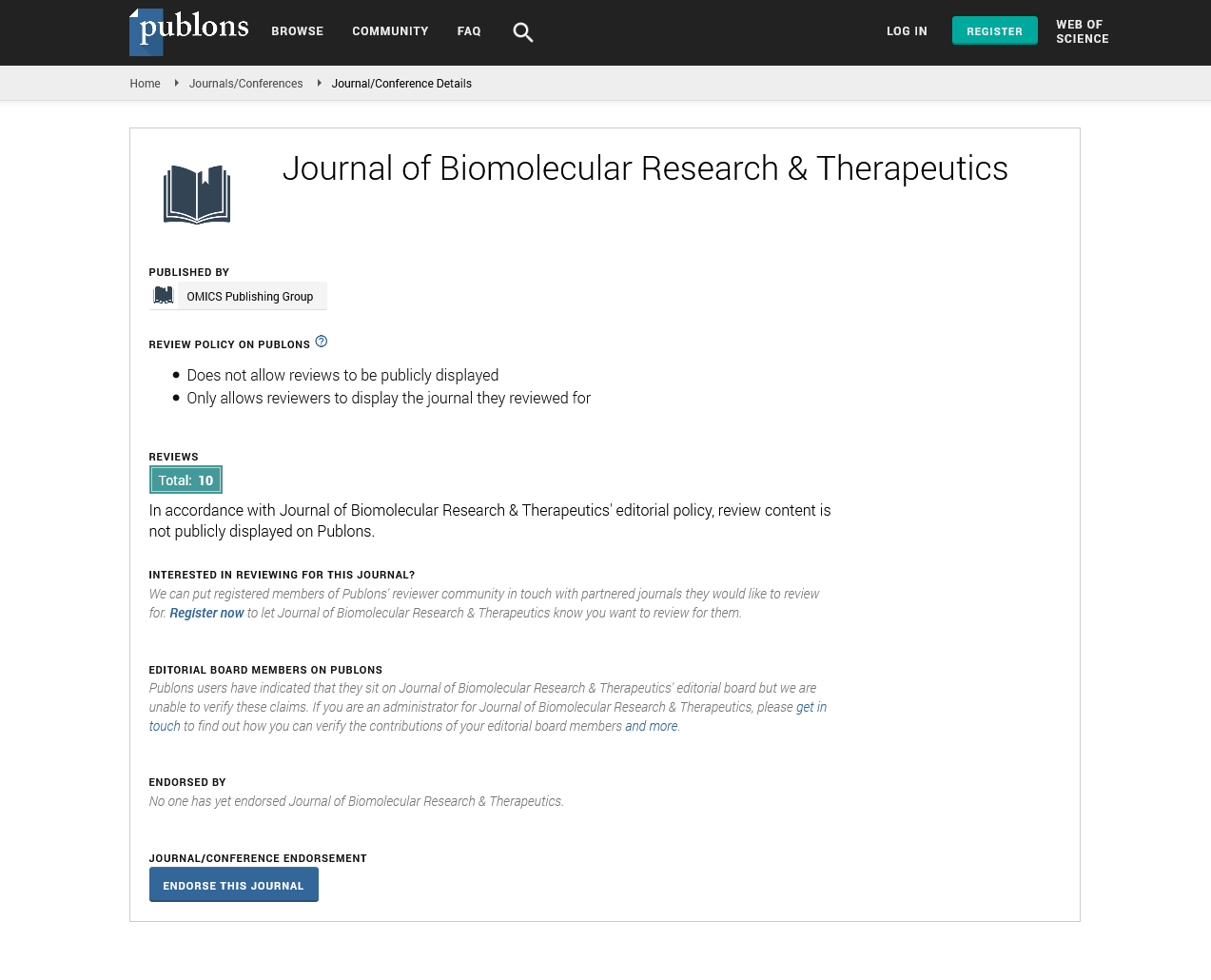Indexed In
- Open J Gate
- Genamics JournalSeek
- ResearchBible
- Electronic Journals Library
- RefSeek
- Hamdard University
- EBSCO A-Z
- OCLC- WorldCat
- SWB online catalog
- Virtual Library of Biology (vifabio)
- Publons
- Euro Pub
- Google Scholar
Useful Links
Share This Page
Journal Flyer

Open Access Journals
- Agri and Aquaculture
- Biochemistry
- Bioinformatics & Systems Biology
- Business & Management
- Chemistry
- Clinical Sciences
- Engineering
- Food & Nutrition
- General Science
- Genetics & Molecular Biology
- Immunology & Microbiology
- Medical Sciences
- Neuroscience & Psychology
- Nursing & Health Care
- Pharmaceutical Sciences
Commentary - (2025) Volume 14, Issue 1
Design and Preclinical Evaluation of Peptidomimetic Inhibitors Against SARS CoV 2 Main Protease
Julia Fischer*Received: 27-Jan-2025, Manuscript No. BOM-25-29313; Editor assigned: 29-Jan-2025, Pre QC No. BOM-25-29313; Reviewed: 12-Feb-2025, QC No. BOM-25-29313; Revised: 18-Feb-2025, Manuscript No. BOM-25-29313; Published: 26-Feb-2025, DOI: 10.35248/2167-7956.25.14.421
Description
The global outbreak of COVID-19, caused by the novel coronavirus SARS-CoV-2, has underscored the urgent need for effective antiviral therapeutics. While vaccines have played a crucial role in mitigating the spread and severity of the disease, emerging variant s and breakthrough infections highlight the necessity for robust antiviral drugs targeting essential viral components. One of the most promising drug targets within the SARS-CoV-2 genome is the Main protease (Mpro), also known as 3CLpro, which plays a pivotal role in viral replication. Mpro processes the viral polyprotein at multiple cleavage sites, enabling the maturation of essential non-structural proteins involved in viral RNA replication and transcription. Inhibition of Mpro, therefore, can effectively shut down the viral life cycle, making it a prime target for antiviral drug development.
In this study, we report the rational design, synthesis and preclinical evaluation of a series of novel peptidomimetic inhibitors targeting the SARS-CoV-2 main protease. Peptidomimetics are compounds that mimic the structure and function of peptides while improving pharmacological properties such as stability, bioavailability and resistance to proteolysis. By leveraging structural insights from the Mpro catalytic site, particularly its conserved cysteine-histidine dyad and substrate-binding pockets (S1, S2 and S4), we designed a library of small-molecule inhibitors featuring electrophilic warheads and non-natural amino acid residues to enhance target engagement and metabolic stability.
The design process began with Structure-Based Drug Design (SBDD) using high-resolution crystal structures of SARS-CoV-2 Mpro. Molecular docking and dynamics simulations guided the placement of critical pharmacophores within the enzyme’s active site. Our lead compound, designated PMI-21, incorporated a P1 glutamine mimic for S1 pocket specificity, a leucine-based P2 residue targeting the hydrophobic S2 site and a reactive α-ketoamide warhead to covalently interact with the catalytic cysteine (Cys145). Additional modifications, such as N-methylation and cyclization, were introduced to enhance oral stability and cell permeability. Following chemical synthesis, the inhibitory activity of PMI-21 and its analogs was evaluated in biochemical enzyme assays using recombinant SARS-CoV-2 Mpro. PMI-21 exhibited potent inhibition with an ICâ??â?? of 18 nM, showing time-dependent covalent binding consistent with mechanism-based inhibition. Kinetic analysis confirmed reversible covalent inhibition with favorable Ki and kinact values. Selectivity profiling against a panel of human proteases and off-target enzymes indicated minimal cross-reactivity, demonstrating high target specificity.
To evaluate antiviral efficacy, cell-based assays were conducted using SARS-CoV-2-infected Vero E6 and Calu-3 cell lines. PMI-21 demonstrated robust antiviral activity with an ECâ??â?? of 120 nM and a Selective Index (SI) greater than 100, indicating potent virus inhibition with low cytotoxicity. Immunofluorescence staining and RT-qPCR analysis showed a significant reduction in viral RNA levels and protein expression post-treatment. In contrast to control compounds and previously reported inhibitors, PMI-21 maintained its efficacy against multiple SARS-CoV-2 variants, including Alpha, Delta and Omicron strains, indicating broad-spectrum potential.
The pharmacokinetic properties of PMI-21 were assessed in preclinical rodent models. The compound displayed acceptable oral bioavailability (42%), a plasma half-life of 5.8 hours and low clearance, supporting once-daily dosing. Liver microsome stability assays indicated minimal metabolic degradation and the compound showed no significant inhibition of major cytochrome P450 enzymes. Additionally, PMI-21 exhibited low plasma protein binding and good permeability in Caco-2 assays, supporting its potential for systemic antiviral application.
In vivo antiviral efficacy was further evaluated using a Syrian hamster model of SARS-CoV-2 infection. Hamsters treated with oral PMI-21 (25 mg/kg daily for five days) showed marked reductions in lung viral titers and histopathological damage compared to vehicle-treated controls. Treated animals exhibited significantly improved weight recovery and reduced lung inflammation, with no evidence of drug-induced toxicity. Histological examination confirmed the preservation of alveolar architecture and reduced immune cell infiltration in PMI-21-treated animals. These findings demonstrate the therapeutic potential of PMI-21 in mitigating SARS-CoV-2 infection and disease progression in vivo.
Toxicological profiling revealed no genotoxicity or cardiotoxicity and acute and sub-chronic toxicity studies in rodents showed an excellent safety profile up to doses of 100 mg/kg. The compound was well tolerated, with no significant changes in blood chemistry, liver enzyme levels, or organ weights. Based on these encouraging results, PMI-21 meets the key pharmacological and safety criteria for advancement toward Investigational New Drug (IND) enabling studies.
Our study highlights the power of peptidomimetic design combined with structural biology and preclinical validation in the development of targeted antivirals. Unlike conventional protease inhibitors that often suffer from poor metabolic stability, our approach overcame these limitations through strategic incorporation of stabilizing features. Moreover, the covalent reversible mechanism of PMI-21 offers an optimal balance of potency and safety, reducing the likelihood of off-target toxicity and resistance development.
In conclusion, we have successfully designed and characterized a novel class of peptidomimetic inhibitors targeting the SARS-CoV-2 main protease. The lead compound, PMI-21, exhibits strong in vitro and in vivo antiviral efficacy, excellent selectivity and a favorable safety profile, positioning it as a promising candidate for further clinical development. Given the ongoing threat posed by emerging variants and the potential for future coronavirus outbreaks, our findings contribute meaningfully to the expanding arsenal of antiviral therapeutics and support the continued development of Mpro inhibitors as essential components of COVID-19 treatment strategies.
Citation: Fischer J (2025) Design and Preclinical Evaluation of Peptidomimetic Inhibitors Against SARS CoV 2 Main Protease. J Biol Res Ther. 14:421.
Copyright: © 2025 Fischer J. This is an open access article distributed under the terms of the Creative Commons Attribution License, which permits unrestricted use, distribution and reproduction in any medium, provided the original author and source are credited.

